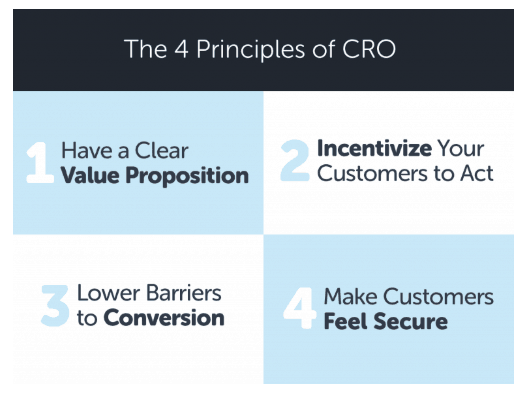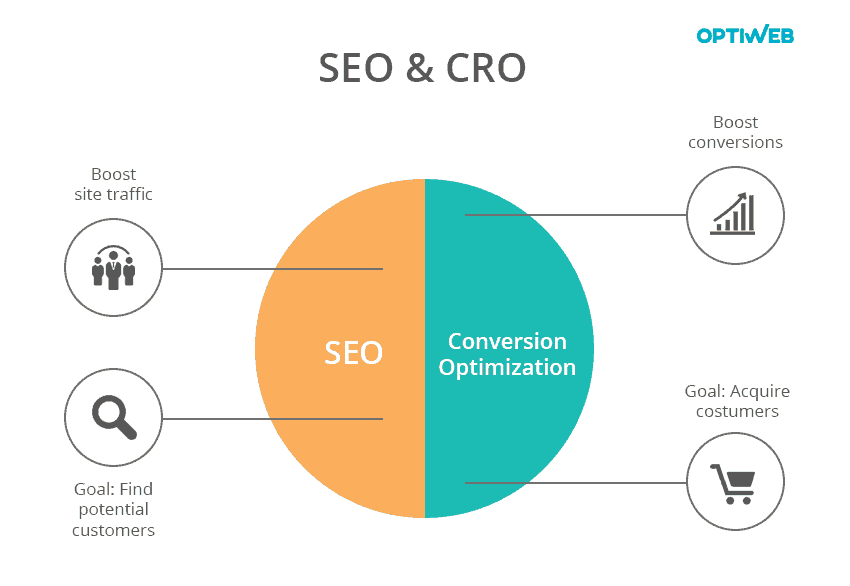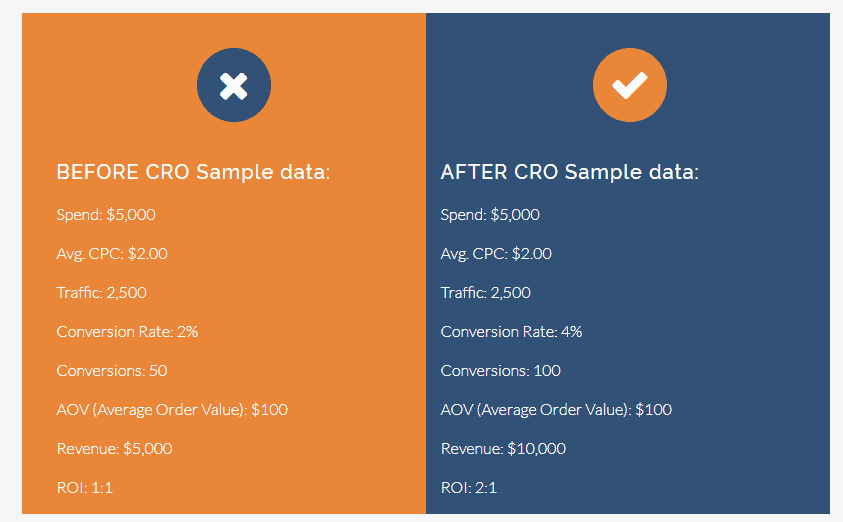
What Is CRO (Conversation Rate Optimization) and How Does It Work?

The online shopping journey of a customer has changed dramatically from the traditional physical shopping experiences of yesteryear. When going into a physical store, you would pick up and look at a few items, make a purchase and then leave. The online experience, however, is much more convoluted. Maybe you clicked on an affiliate ad and were taken to a site that you weren’t ready to really investigate at that moment so you click off of it. Days later, you see a re-targeting ad for that same site, decide to go check out some online reviews and then head over to the site again, this time to read some evergreen blogs on related subjects.
In fact, you can have multiple touch points before finally going to the online product page to make a purchase.
Because of the chaotic nature of the online shopping experience, it’s more important than ever to have a plan for predicting and leading the actions of consumers that come to your site. Traffic is all well and good, but unless a conversion takes place and a new customer is made, you’ve missed an opportunity. CRO is the process whereby you can make a value proposition, remove barriers, incentive your customers to act and improve overall conversion on your eCommerce site.
What is CRO?
So what is CRO and what does CRO stand for? Also, how does CRO apply to marketing plans? How does CRO differ from SEO? Find answers to all your CRO questions below.
CRO Meaning
CRO is a marketing acronym that stands for Conversion Rate Optimization. CRO is the overall process of improving the conversion rate in online marketing or advertising via different methods of optimization. The CRO marketing acronym is used to focus mainly on marketing and optimizing for conversion.
How Does CRO Apply Specifically to Marketing?
CRO relates directly to marketing since it helps improve the end goal of your marketing plan efforts; that is, conversion. Conversion simply means that a visitor acted upon a call to action. The call to action, or (CTA), can differ depending on what it is you want the customer to do.
For example, if you are marketing a landing page that asks people to click a link to sign up on a mailing list, CRO would be the methodology of increasing the rate of mailing list sign ups on that specific page.
One way of trying to increase sign ups in this example could be writing a better CRO CTA, changing the layout of the page or improving the content with more convincing language.
Here is a simple graphic from Liquid Web that does a great job of summing up a few of the basic principles of CRO online marketing:

Screenshot taken 11.25.19 from liquidweb.com
The overall end goal is to help your visitors turn into customers that keep coming back time and time again.
The Guiding Principles of CRO
While there are many tactics that can be used to improve your CRO, it’s important to make sure you stick to the principles that guide this form of marketing optimization. They include the following:
1. Start with a Value Proposition
If you offer no real benefits to the consumer that are different than the competition, few will move on in your sales funnel. Whether your value prop is price, quality, value, convenience, you need to make it clear immediately. Try to make your case through design choices, copy choices and navigation choices. Keep it simple, clear and concise and customers will want to know more.
2. Motivate Customers To Keep Going
Customers always want to feel like they are getting a deal – nobody wants to pay full price! Discounts, free trials, BOGO coupons and store credit are all great ways to help increase your conversions.
While you can help customers to feel like they are on the “inside” by offering special rates and discounts while they are on your site, there’s even more that can be done. You can build authority and trust with potential customers by having easy-to-access information on how the process works, money-back guarantees, and total customer satisfaction. In fact, a really good “About Us” page can be a huge boost to conversions because customers will feel like they trust and know you. Quality pictures of products and grammar-free product descriptions increase that trust.
Lastly, if you put out great blogs posts that are informational and entertaining to read, you can increase exposure when clients share those posts on social media channels and sign up for your blog newsletter.
3. Reduce Conversion Barriers
Almost as important as motivating your customers is removing the roadblocks. You may have a great product/service, compelling discounts, and impressive design, but if you have too many barriers you’re going to lose business. People will only jump through so many hoops before moving on. Some common barriers to conversion include:
- No images
- Poor product copy
- Grammar/Spelling errors in the content
- Slow load times
- Forcing customers to give personal info to get pricing
- Not enough information
- Too much information
This is just a small list, but there are many more. Be careful in your CRO marketing efforts that you don’t create extra barriers while making changes.

4. Make Customers Feel Comfortable
If your site looks sketchy, fake or insecure – customers will leave. Remember, they’re entrusting personal information as a part of the conversion process – whether it be a name, email address, physical address, phone number or credit card number. The last thing people want to do is to get scammed.
There are a lot of things that add to helping a customer feel comfortable. The layout of your homepage. The wording and messaging of the content. The usage of plugins on your site (like pop-up ads which are known to increase conversion at times but come across as annoying).
Take into account how your potential customers might react to any part of your marketing plan before you implement it. You don’t want to sacrifice your customer’s trust and loyalty over a quick conversion.
How Do you Find Your Conversion Rate?
In order to increase your conversions, it’s probably a good idea to know how to calculate your current conversion rate on your site. So what is your conversion rate? It’s actually pretty easy to find if you have the right data available. Here is the formula to find it:
CR = Total # of Conversions + Total # of Visitors
Basically, if you had a landing page that led people to sign up for your mailing list, first look at how many signed up for your mailing list. Let’s say 50 signed up. Next, look at the total number of people that visited that page. Let’s say 500 people visited the page. You’d then divide the total number of people that visited the site (500) by the number that signed up (50). Your CR for mailing list signups would be 10% (500/50). This can be done for any “conversion” metric that you want to start improving.
CRO vs. SEO
Many people confuse CRO and SEO, but the truth is that while they are two different things, they help each other and complement each other.
Search engine optimization (SEO) is the practice of optimizing pages and content to be better read and ranked by the search engines. CRO is more focused on optimizing for human behavior, but you can’t get the people to your page without SEO. CRO and SEO go hand-in-hand and must be used together in order to give yourself the best potential of increasing conversion rates.
In the example we used above about the landing page designed to lead visitors to sign up for a mailing list, SEO would be the process of making sure the right search keywords are within content, the meta descriptions and title tags are optimized, as well as making sure a good link structure exists. CRO would instead focus on the content’s ability to adequately convince the visitor to sign up for the mailing list.

Screenshot taken 11.25.19 from optiweb.com
From the image above, CRO vs SEO is broken out into two halves, with one half focusing on page views and the other half focusing on conversion. As you can see, it’s hard to have one without the other, but the thinking and CRO marketing strategy is fundamentally different than the SEO strategy.
What is CRO Marketing Used For?
Ok, so we’ve defined what CRO is and how it’s different (but complementary to SEO), but why should you invest your marketing time and money into it? The truth is that if you can better predict and control how your customers will behave when they reach your site, the more you can increase your profits. CRO can directly improve your bottom line. Here are a few specific benefits of Conversion Rate Optimization.
CRO Improves Marketing
Have you ever seen a billboard or a printed advertisement with a message that doesn’t make it clear what the company does or what it wants you to do? The saddest part about this is that the company paid a lot of money and spent a lot of internal resources to create and distribute those lackluster advertisements.
With the implementation of proper CRO, the ads would have been more clear and hopefully increased the desire for the reader to act, or convert into a sale. This would have not only increased the ROI of this specific marketing campaign, but it could improve the ROI of all of the other company’s investments that were made to drive customers to see the ads.
CRO Improves Traffic
When your ads are more clear, the right people make it to your site. When the right people make it to your site, make a purchase and have a good experience, the more likely they are to share your products and services with those that they know either through social media, reviews or word of mouth.
Traffic can thus be improved by first targeting WHO you’re bringing to the site and then increasing HOW many are coming.
CRO Improves Customer Satisfaction
No one wants to go to a website where it’s not clear what to do next. The second you get confused about where to go or what to do, is the second you click off that site and don’t go back. CRO has a tendency to put the customer first because you’re making decisions based on how you think your customers will react and what will help them feel comfortable and natural in their exploration of your site. This means you can align your design, content writing, ad copy and site navigation with your customer’s preferences.
As you can see, CRO can help everyone else upstream that is putting time and effort into any type of marketing campaign, which is why CRO marketing is so important for companies to focus on. CRO marketing, if properly executed, can help the bottom line of any company.

How Do You Implement CRO?
Now for the good stuff. How do you actually implement CRO into your marketing efforts?
- First, identify the conversions that need improvement. Don’t just say “ALL THE CONVERSIONS!”. Try to pinpoint a place to start and then work from there. This could mean working on your product pages with the most traffic, or your contact us page. Make sure you pick pages that have enough traffic already that you’ll be able to track improvement.
- Next, gather the data for these conversion pages. How much traffic do they get? What is the current conversion rate? What is the path a customer takes to get to that conversion?
- Third, Hypothesize. Based on your data, make calculated guesses on how your customer will react to different situations. This could be in regards to design choices, copy and button placement.
- Fourth, do some small-scale testing. Make small changes and track the data. Don’t make too many changes at once or you won’t know what changes spurred the increase in conversions. The key is to find actionable things you can do at scale to increase conversions across the board.
- Fifth, honestly analyze your results. If your testing made things worse, then what happened? If it made things better, then how come? Can you continue on that train of thought to increase conversions even more?
- Last of all, repeat this process. If you’re continually working on your CRO, you’ll find answers. If you only test a couple of times, you’ll never really know what your ceiling is. Keep at it and you’ll find what’s working.
A/B Testing Is Key
In regards to the “testing” bullet above, we wanted to delve a little deeper into how you can make that really effective. While it is ideal to start a marketing campaign with CRO in mind, sometimes it’s hard to know how something will perform without running a campaign. Also, sometimes clarification or confusion don’t rear their heads until after a digital ad has been made live. In these situations, CRO and A/B testing should be used to find the best combination.
A/B testing is much easier to implement with digital advertising as a small/large tweak can be made to a campaign and run concurrently to the original in order to gather data as to which version of the campaign increases the rate of conversions. This sort of A/B testing can be done on the fly and can provide you with a gold mine of information to help you know what phrases, words, placement, etc. works best for your customers for that specific campaign.
To help make this point, the following graphic shows how you can essentially double revenue by spending the same PPC budget but testing the messaging until you find the combination that gives you the best results:

Screenshot taken 11.25.19 from verticalmeasures.com
As you can see, optimization can make the same budget go twice as far with effective CRO advertising.
What is CRO Methodology?
For those of you that love a formula for this sort of thing, you’re in luck! MECLABS Institute developed a methodology in 2007 which has since been patented as the Conversion Sequence Heuristic. Here is how the formula looks:
For the rest of us that aren’t math wizards, stick to the basics of finding your conversion rates for specific actions, and then utilize CRO marketing tactics to improve the experience for the customer. From there, track your results and use A/B testing to incrementally discover the ways to improve conversions even higher.
What is CRO? A Vital Online Marketing Tool
So what is CRO? CRO is crucial to helping online marketing campaigns succeed. In our digital world, CRO marketing can be implemented on the fly with A/B testing, analytics and can be boosted by good SEO practices. If you are needing some help getting your marketing copy to better connect with your customers to increase ROI, we can help! Check out our content writing services to get you some amazing content that will resonate with your customer base.
- The Google Quick Answer Box: What, Why and How? - December 20, 2023
- Top 10 Link-Building Strategies for Content Marketers - July 12, 2023
- 8 Types of Ecommerce Content You Should Start Using - May 15, 2023


